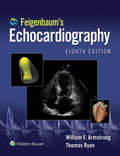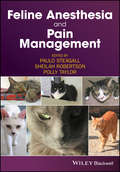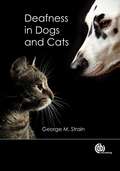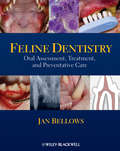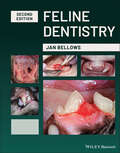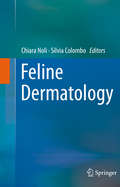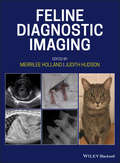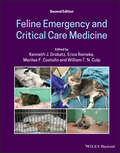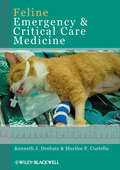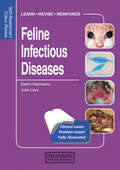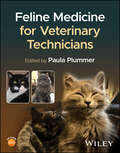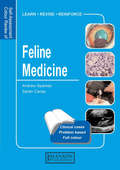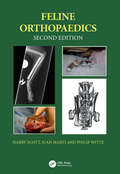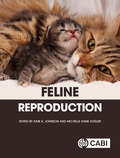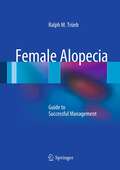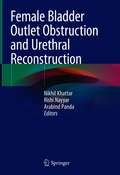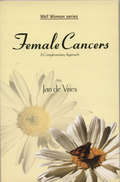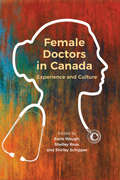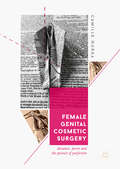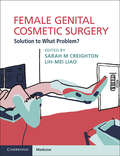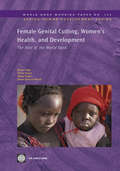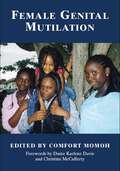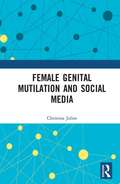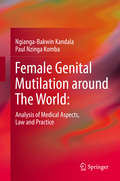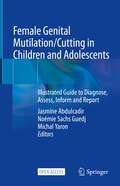- Table View
- List View
Feigenbaum's Echocardiography: Ebook without Multimedia
by Thomas Ryan William F. ArmstrongPublisher's Note: Products purchased from 3rd Party sellers are not guaranteed by the Publisher for quality, authenticity, or access to any online entitlements included with the product. Continuing the long-standing Feigenbaum tradition as an authoritative, comprehensive echocardiography resource, the thoroughly revised Feigenbaum's Echocardiography, Eighth Edition, helps echocardiographers, fellows, clinicians, and sonographers master the art and science of echocardiography and stay current with all that’s new in the field. Written by William F. Armstrong and Thomas Ryan, it guides you through pertinent physics, technology, clinical applications, and new developments in the field. As in the past, the book is written primarily for the practitioner who uses echocardiographic methods to care for and manage patients, with a focus on appropriate clinical applications.
Feline Anesthesia and Pain Management
by Sheilah A. Robertson Paulo Steagall Polly TaylorFeline Anesthesia and Pain Management offers a definitive and practical guide to feline anesthesia and pain management. The only book offering detailed practical information on anesthesia and pain management in cats, one of the world’s most popular pets World renowned author team Quick reference format with full color illustrations Offers detailed practical information on anesthesia and pain management tailored to the unique needs of cats Includes a team of world-renowned authors who are experts in veterinary anesthesia and analgesia Uses a quick reference format that makes the information easy to find and follow Presents full color images to illustrate concepts
Feline Behaviour and Welfare
by Andrew Fraser Rhona LoptsonCats are the world's most popular domestic pet, as well as being wild animals. This comprehensive book on feline behaviour explores both the familiar domesticated animal and wild relatives such as the leopard, tiger and lynx to examine the Felidae family as a whole, allowing for fascinating comparisons between wild and domestic species and explanations of behaviour in pet cats with evolutionary origins. Fraser's work helps increase readers' understanding of cat behaviour - why they behave as they do, for what purpose and why. The focus is on identifying normal behaviour from the cat's perspective, with a welfare theme running throughout; as exhibitions of normal behaviour provide evidence of good welfare, and abnormal behaviour can be an indicator of poor welfare. Providing a veterinary perspective - by including coverage of feline physiology, life stages and reproduction - as well as an ethological one, this is an important read for veterinarians, shelter workers, animal behaviourists and students of veterinary medicine and animal welfare, while also being of interest to pet owners.
Feline Dentistry
by Jan BellowsFeline Dentistry: Oral Assessment, Treatment, and Preventative Care is the only current reference devoted to feline dentistry. It brings together information on anatomy, pathology, radiology, equipment, materials, anesthesia, treatment, medical, and surgical dental care of the cat. This text serves as a guide to the diagnosis and management of general dental problems as well as problems unique to cats. Separated into three sections?assessment, treatment, and prevention?this full color book is an essential reference for any veterinarian treating feline patients.
Feline Dentistry: Oral Assessment, Treatment, And Preventative Care
by Jan BellowsThe most up-to-date version of the leading resource on veterinary dentistry in cats The Second Edition of Feline Dentistry delivers a comprehensive exploration of the specific considerations required to provide dental care to cats that emphasizes their unique needs. The updated Second Edition includes brand-new material and approximately 300 new images illustrating diseases, conditions, and procedures discussed within the book. The new edition combines the pathology and treatment information to provide additional context which helps make it more clinically relevant. The book also offers: A thorough introduction to feline oral assessment, including anatomy, oral examinations, radiology, and charting Comprehensive explorations of dental pathology and treatment in cats, including necessary equipment and materials and anesthesia and pain control Practical discussions of dental pathology prevention in felines, including plaque and tartar control Perfect for veterinary general practitioners and veterinary students, Feline Dentistry Second Edition will also be useful to veterinary technicians seeking a one-stop, visual resource on feline-specific dentistry.
Feline Dermatology
by Chiara Noli Silvia ColomboThis richly-illustrated handbook covers all aspects of modern feline dermatology, from the approach to different signs and symptoms to the description of the etiology, pathogenesis, clinical manifestation, diagnosis and current treatment of each feline dermatological disease. Thus this manual serves as essential practical guide to the busy practitioner to quickly and surely tackle cats with dermatological conditions, and offers a current and complete reference tool for the feline veterinarian and the veterinary dermatologist.
Feline Diagnostic Imaging
by Merrilee Holland Judith HudsonThis book offers a comprehensive resource for imaging the feline patient, with an emphasis on the unique considerations of imaging cats. It focuses on radiology and ultrasound, with some coverage of advanced imaging such as computed tomography and magnetic resonance imaging. Incorporating more than 1750 high-quality images, it is an invaluable reference for any veterinary practitioner with a significant feline caseload. Feline Diagnostic Imaging begins with information on the radiographic evaluation of the thorax, abdomen, and musculoskeletal structures, including normal anatomy and pathology, followed by a review of common echocardiographic and abdominal ultrasound findings and abnormalities. Advanced imaging of the skull using computed tomography and magnetic resonance imaging cases of brain and spinal disease are also included. The book: Provides imaging information specifically tailored to the particular needs of cats Emphasizes the modalities most commonly used in general practice, with some discussion of advanced imaging Gives a complete overview of diagnostic imaging for the feline patients Includes tips and tricks for the unique considerations of working with cats Presents essential information for any practitioner treating feline patients Offering a feline focus not found in other imaging books, Feline Diagnostic Imaging is an essential purchase for veterinarians wishing to improve their diagnostic imaging skills in cats. It’s also an excellent guide for veterinary radiologists, and veterinary students and residents.
Feline Emergency and Critical Care Medicine
by Kenneth J. Drobatz Merilee F. Costello Erica Reineke William T. N. CulpA concise and practical quick reference for veterinary practitioners dealing with feline emergencies The updated Second Edition of Feline Emergency and Critical Care Medicine delivers a practical guide for veterinary practitioners dealing with injured or ill cats. The book focuses on clinically oriented information tailored to a fast-paced emergency setting. Perfect as a quick reference—with a concise outline format designed to facilitate immediate access to critical information—this edition of the popular book emphasizes the skillful and informed management of feline veterinary emergencies. The new edition of Feline Emergency and Critical Care Medicine also includes: A thorough introduction to veterinary approaches to the care of critically ill cat, cardiopulmonary-cerebral resuscitation, shock, and trauma Comprehensive explorations of anesthetic protocols for systemically healthy cats and pain management in critically ill feline patients Practical discussions of general approaches to neurologic emergencies, including those involving the brain, spinal cord, and peripheral organs In-depth examinations of a wide variety of emergency surgical procedures, including gastrointestinal, urinary, and other surgeries Feline Emergency and Critical Care Medicine, Second Edition is an invaluable resource for feline and small animal veterinary practitioners and emergency and critical care specialists.
Feline Emergency and Critical Care Medicine (Coursesmart Ser.)
by Kenneth J. Drobatz Merilee CostelloFeline Emergency and Critical Care Medicine is the first book to focus specifically on feline-specific emergency and critical care. Designed as a quick-access manual of emergency and critical care procedures, information is presented in an easy-to-follow outline format. With an emphasis on the unique considerations for treating cats, this book provides all the information needed to confidently manage the feline critical patient.
Feline Infectious Diseases: Self-Assessment Color Review (Veterinary Self-assessment Color Review Ser.)
by Katrin Hartmann Julie LevyThis book covers all types of feline infectious diseases, including infections caused by viruses, bacteria, parasites and fungi. 199 clinical cases are presented randomly, as in practice, but the wide range of cases cover infectious diseases which affect all the organ systems of the cat. The illustrated clinical cases contain integrated questions a
Feline Medicine for Veterinary Technicians
by Paula PlummerA comprehensive overview of feline medicine in a clinical setting for the veterinary technician Feline Medicine for Veterinary Technicians is a complete, specialty reference guide, written by veterinary technician specialists, for the veterinary technician to use in a feline medicine clinical setting. Covering everything from the pathophysiology of common feline diseases, current therapies and nursing care, diagnostic techniques, unique history taking methods, and nursing care in every major body system. It is a critical tool for anyone preparing for a specialty exam or the Veterinary Technician National Exam (VTNE). Feline Medicine for Veterinary Technicians readers will also find: Coverage of cutting-edge diagnostics, treatment options, and moreDetailed discussion of topics including feline friendly interactions, life stage considerations, client communication, pharmacology, and many moreA team of contributors with decades of combined veterinary technician experienceA comprehensive review of diseases in all major body systems including endocrinology, cardiology, renal and urinary systems Feline specific considerations for behavior, anesthesia, analgesia, transfusion medicine and nutritionThe companion website includes study questions for all chapters, as well as client education materials, dental positioning guidelines and educational handouts Feline Medicine for Veterinary Technicians is ideal for students as well as anyone preparing for a specialty exam or as a veterinary technician in feline clinical practice.
Feline Medicine: Self-Assessment Color Review (Veterinary Self-Assessment Color Review Series)
by Andrew Sparkes Sarah M.A. CaneyIn this new volume, part of the Veterinary Self-Assessment Colour Review series, the authors aim to cover all aspects of feline medicine. Questions cover areas such as dermatology, ophthalmology, urinary tract, oral cavity/oesophagus, GI tract, endocrinology, cardiology, respiratory disease, infectious disease, reproductive disease, neuro-muscular
Feline Orthopaedics
by Harry Scott Juan M. Marti Philip WitteCats are not referred to specialists as frequently as dogs, meaning the general practitioner must routinely treat cats that have been involved in road traffic accidents and other musculoskeletal trauma. This book is the first of its kind to provide a practical and user-friendly guide to feline orthopaedics. With a new author team, led by RCVS Specialist in Small Animal Surgery (Orthopaedics) and Veterinary Neurology Harry Scott, the second edition has been thoroughly revised and updated. New chapters cover Physiotherapy and Oncology of the Feline Skeletal System. The book includes highly structured fully referenced text that provides a concise, straightforward guide to the recognition and management of specific diseases and conditions. In this new edition, the neurological causes of lameness have been given more in-depth discussion, with an emphasis on early recognition of clinical signs and diagnosis. The disorder sections are now divided into those likely to be associated with trauma (fractures and luxation) and those which are congenital or developmental. The text is supported by high quality radiographs, colour photographs and colour line drawings to illustrate principles, techniques and procedures. Combining their experience in practice and education, the authors have produced a book that appeals to general practice veterinarians, specialist feline practitioners and to students.
Feline Reproduction
by Natalie S Fraser Carla Barstow Marco Cunto Diane Delmain Jaime M. Douglas Alain Fontbonne Cristina Gobello Sandra Goericke-Pesch Fiona Hollinshead Jacob A. Johnson Cindy Maenhoudt Jennifer Nagashima Zuzanna Niewiadomska Budhan Pukazhenthi Juliette Roos William F. Swanson Riley E. Thompson Lindsey M. Vansandt Daniele ZambelliCats are one of the most popular pets in the world and cat owners want advanced veterinary care. There is a growing interest in purebred cats which requires the highest quality reproductive care from the general veterinary practitioners. In Feline Reproduction, all aspects of reproduction in the queen and the tom are presented by a global author team. Beginning with basic anatomy and normal reproduction, this book reviews practical knowledge about feline pregnancy, neonatal care, breeding soundness exams, and semen cryopreservation. This book also provides the most current and comprehensive information about abnormal conditions affecting feline reproduction, such as infertility, spontaneous abortion and contraception. Covering both pets and nondomestic species, this feline reproduction book will prove to be essential for the general veterinary practitioner, veterinary student, animal scientist, and experienced cat breeder.
Female Alopecia
by Ralph M. TrüebFew dermatologic problems carry as many emotional overtones as hair loss in women, which is by far the most common hair problem encountered in daily clinical practice. Fortunately, a specific diagnosis can usually be established through the application of appropriate examinations and tests, and treatment suited to the diagnosis is likely to control the problem. This comprehensively illustrated monograph provides both specialists and primary care physicians with the practical know-how required for successful management of hair loss in female patients of all ages. The book opens by critically examining various myths about hair loss. The different examination techniques are then described, and the various forms of hair loss and their treatment are discussed in detail. Approaches to follow-up are outlined, and the management of patient expectations is carefully considered. The potential role of hair care and cosmetics is also explored in some depth.
Female Bladder Outlet Obstruction and Urethral Reconstruction
by Nikhil Khattar Rishi Nayyar Arabind PandaUrinary symptoms in women have a very high prevalence rate. While the storage function of the bladder is similar in both genders, voiding function has marked differences with obvious anatomic and physiological genitourinary distinctions. Despite all advances in contemporary diagnostics and imaging, female bladder outlet obstruction and urethral stricture disease remain a conundrum to be deciphered in clinical practice. It is also seen that the female voiding symptoms and bladder outlet obstruction are poorly understood entities; which is also evident from the fact that Urethral dilatation in women is still a widely practiced procedure. This book provides a comprehensive understanding of female voiding disorders leading to bladder outlet obstruction and helps identify the women who will actually need reconstructive surgeries. The book begins with what is normal female voiding and then goes on to describe the various definitions of female bladder outlet obstruction along with controversies in Urodynamic diagnosis . As the functional causes are more common than actual strictures, this book elucidates on the knowledge of each of these differentials with their basic understanding and treatment outline, further throwing knowledge on the anatomical causes like pelvic organ prolapse and female urethral stricture. A separate section is dedicated to female urethral surgical anatomy and urethral reconstruction for urethral stricture as well as pelvic fracture urethral injury in females.
Female Cancers: A Complementary Approach
by Jan de VriesTo many people, being diagnosed with cancer is tantamount to a death sentence and among women, rates of breast and ovarian cancers are still very much on the increase. Conventional treatments such as radiotherapy and chemotherapy can have horrific side effects, and doctors and specialists are only too happy when patients adopt additional complementary methods of combating the disease. Female Cancers, the latest title in the popular Well Woman series by Jan de Vries, succinctly addresses the main issues involving the treatment of cancers affecting women today. It advises on the ways that women can decrease the likelihood of contracting the disease and explains what sufferers can do to improve their chances of recovery.The book focuses on the confusion regarding the link between HRT and cancer, and further investigates the foods widely reported to cause the disease. It reveals how alternative medicine can help, for instance, by building up the patient's immune system to stand up to the attacks of agressive therapies. Jan de Vries has worked in this field for over 45 years and is a member of several research committees, including the Cancer Control Society. In Female Cancers, he shares his up-to-date knowledge of the new developments of cancer therapy and signposts the complementary help that can be given to assist female cancer patients.
Female Doctors in Canada: Experience and Culture
by Shelley Ross Earle Waugh Shirley SchipperFemale Doctors in Canada is an accessible collection of articles by experienced physicians and researchers exploring how systems, practices, and individuals must change as medicine becomes an increasingly female-dominated profession. As the ratio of practicing physicians’ shifts from predominately male to predominately female, issues such as work hours, caregiving, and doctor-patient relationships will all be affected. Canada's medical education is based on a system that has always been designed by and for men; this is also true of our healthcare systems, influencing how women practice, what type of medicine they choose to practice, and how they wish to balance their personal lives with their work. With the intent to open a larger conversation, Female Doctors in Canada reconsiders medical education, health systems, and expectations, in light of the changing face of medicine. Highlighting the particular experience of women working in the medical profession, editors trace the history of female practitioners, while also providing a perspective on the contemporary struggles women face as they navigate a system that was tailored to the male experience, and is yet to be modified.
Female Genital Cosmetic Surgery: Deviance, Desire and the Pursuit of Perfection
by Camille NurkaExamining the fascinating history of female genital cosmetic surgery, Camille Nurka traces the origins of contemporary ideas of genital normality. Over the past twenty years, Western women have become increasingly worried about the aesthetic appearance of their labia minora and are turning to cosmetic surgery to achieve the ideal vulva: a clean slit with no visible protrusion of the inner lips. Long labia minora are described by medical experts as ‘hypertrophied,’ a term that implies deformity and the atypical. But how far back does the diagnosis of labial hypertrophy go, and where did it originate? Female Genital Cosmetic Surgery tells the story of the female genitalia from the alien world of ancient Greek gynaecology to the colonial period of exploration and exploitation up to the present day. Bringing together historical, medical, and theoretical documentation and commentary, Nurka uncovers a long tradition of pathologizing female anatomy, a history sure to be of interest to any reader who wishes to know more about how medicine shapes our commonly held ideals.
Female Genital Cosmetic Surgery: Solution to What Problem?
by Sarah M. Creighton Lih-Mei LiaoAn analysis of the cultural and economic drivers of the growing phenomenon of FGCS, written by cross-disciplinary experts, this book challenges the concept of individual consumer choice in FGCS: a decision that is rarely exercised in a socio-cultural vacuum. Four distinct aspects of FGCS are covered: variations in female genital anatomy; surgical techniques and evidence; historical contexts and ethical dilemmas; norm-critical understandings to inform professional responses. Rendering philosophical critiques accessible, and exposing dubious social values that underpin the practice, this text is crucial in driving a broader understanding of FGCS as a cultural phenomenon of our times. Only with a fuller understanding of the multiple perspectives of FGCS, can there be sensible alternatives for women and girls psychologically troubled by their natural, healthy form. Offering explanations and interventions at individual, institutional and societal levels, this text will be valued by both professional and non-professional audiences.
Female Genital Cutting, Women's Health, and Development
by Khama Rogo Tshiya Subayi Eiman Hussein Sharief Nahid Toubia'Female Genital Cutting, Women's Health, and Development' provides a comprehensive understanding of the issue of female genital mutilation/cutting-scope, challenges, opportunities, best practices, and how communities, development agencies, and national governments can work together to eliminate the practices on the ground. The World Bank is committed to assisting governments in ending the practice of female genital cutting, as the practice has direct, negative impact on the health and well-being of women around the world. The recommendations set forth in this paper take advantage of the World Bank's comparative advantage in dealing with governments. Continued silence perpetuates the practice, thereby undermining women's productivity.
Female Genital Mutilation
by Comfort MomohThis unique book will assist those who care for women and girls who have had, or are at risk of having female genital mutilation. It focuses on caring for both physical and mental needs of the vulnerable or suffering and maintains an understanding, holistic and objective approach to the current situation. It contains colour plates, illustrations, p
Female Genital Mutilation and Social Media
by Christina JuliosThis book explores the phenomenon of anti-femail genital mutilation (FGM) social media activism. Against a backdrop of over 200 million girls and women worldwide affected by FGM, this volume examines key global online campaigns to end the practice, involving leading virtual platforms such as Twitter, Facebook and YouTube. Drawing from twenty-one fieldwork interviews with anti-FGM activists, frontline practitioners and survivors, the volume investigates opportunities and challenges inherent to cyberspace. These include online FGM bans as well as practices such as ‘cyber-misogyny’ and ‘clicktivism’. Global campaigns featured include the UN’s International Day of Zero Tolerance for FGM, the WHO’s Sexual and Reproductive Health Programme, The Girl Generation, The Guardian’s End FGM Global Media Campaign and the Massai Cricket Warriors. Furthermore, ten case-studies document prominent anti-FGM campaigners. Firstly, five African-led narratives from celebrated activists: Efua Dorkenoo OBE, Waris Dirie, Ayaan Hirsi Ali, Jaha Mapenzi Dukureh and Leyla Hussein. Second, five accounts from FGM survivors interviewed for the book: Mama Sylla, Masooma Ranalvi, Farzana Doctor, Fatou Baldeh and Mariya Taher. By exploring anti-FGM online activism, this book fills a gap in the literature which has largely overlooked FGM’s presence in cyberspace as a virtual social movement. Female Genital Mutilation and Social Media will be of interest to activists, survivors, frontline professionals, students, academics and the wider public.
Female Genital Mutilation around The World: Analysis of Medical Aspects, Law and Practice
by Ngianga-Bakwin Kandala Paul Nzinga KombaThis book uses global household data to examine the prevalence, trends and geographic variation of female genital mutilation (FGM) around the world. It also addresses the underlying legal and policy aspects as well as explores the medical consequences, both immediate and long term, for those undergoing the practice. The book analyses the position of victims of this gender-based violence both from the medical and legal perspective and adopts a largely practical approach to the study of the practices, offering a fresh thinking into one of the challenges in global health and the law. In addition, it offers some insights into how health professionals can approach this category of victims and how legal practitioners can obtain a good legal result for their clients before domestic and international forums. The book addresses fundamental issues such as state liability and defences in enforcement proceedings for actions or omission of state or non-state actors, and due diligence standard in international human rights law, the main gateways available for obtaining relief for the victims of FGM. This book goes beyond the traditional debate between zero tolerance and those who wish to see the practice medicalised and tolerated and favours an advocacy programme standing firmly in favour of the right of FGM victims. This book offers a unique perspective likely to assist victims and their representatives to secure a remedy against perpetrators and the state. As such this book will be of interest to medical professionals, national and international lawyers, academics and policymakers in the field of public health.
Female Genital Mutilation/Cutting in Children and Adolescents: Illustrated Guide to Diagnose, Assess, Inform and Report
by Jasmine Abdulcadir Noémie Sachs Guedj Michal YaronThis open access illustrated guide focuses on Female Genital Mutilation/Cutting (FGM/C) in children and adolescents. FGM/C comprises all procedures that involve partial or total removal of the external female genitalia or injury to the female genital organs for nonmedical reasons. It is mainly carried out during childhood, before the age of 15. The signs of FGM/C can be subtle, and the examiner must be trained with a wide range of normal genitalia both before and after puberty, FGM/C types and subtypes, complications and differential diagnosis. This volume is a reference containing iconographic material of both pre and post pubertal genitals with and without genital cutting. This book will guide health care professionals in making the correct diagnosis, outline the clinical management, enhance patient–provider communication, and will enable accurate recording and reporting to governments where required.
